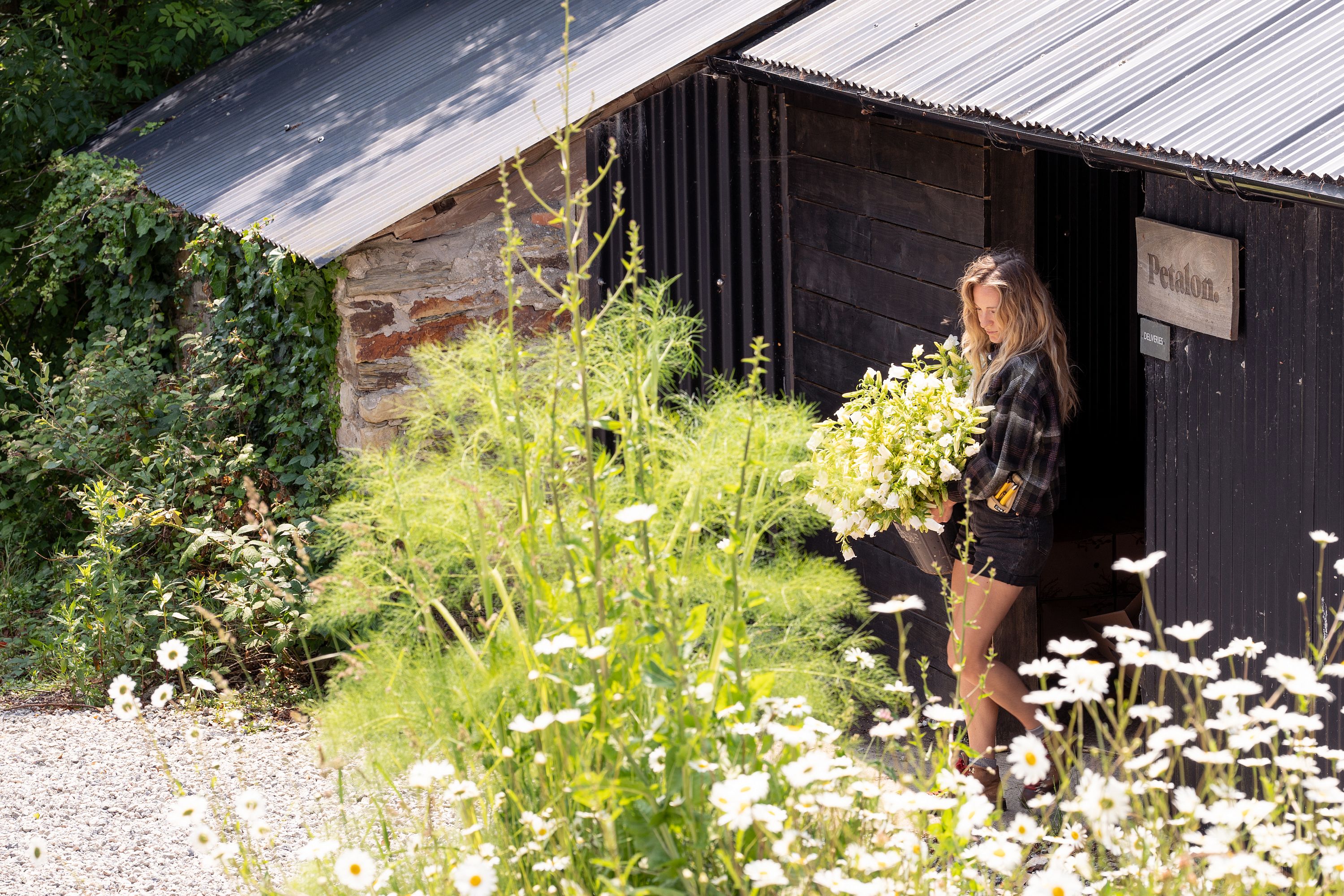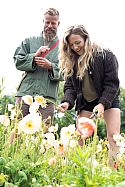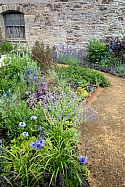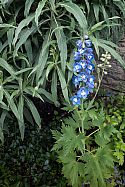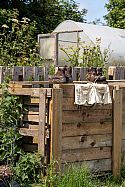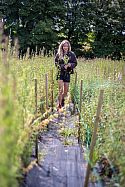Petalon
In fair weather and outside of the holiday season, the three-hour drive from Niwaki HQ on the Wiltshire/Dorset border to the Petalon farm in Cornwall is a welcome gift to an overworked brain. Three hours of idle introspection while listening to a handful of albums from start to finish (no skipping), or perhaps time to catch up on an edifying gardening podcast*. But those leisurely pursuits would have to wait for the return journey; instead, I chose to repeat, like a mantra, the name “Petalon” to try and avoid referring to my hosts’ business as “Pelaton” by mistake. And what do you think happened as soon as I opened my mouth?
Back in the heady days of 2014 when Petalon was founded in East London, the play on words signalled the fact that founder Florence was cycling to the flower market at 4am, returning home to arrange her floral bounty before hopping back on her bike to deliver her creations all across London. A lot of healthy cycling, but not a timetable that is hugely conducive to family life.
By 2020, life was moving on, the business was growing, and children were exerting their disruptive influence, so, with husband James now managing the commercial side of things, they sniffed out a farmhouse being sold at auction. The place was in dire need of ‘modernisation’, but they saw potential. As I was to discover, Florence and James dream big and see potential where some just see difficulties and hard work.
So they packed up their family and moved a few hundred miles south and west to a farm in rural Cornwall. No more bike deliveries but plenty of space, fresh air, and Cornish sun to swap pedal power for petal power and begin establishing what is now a thriving and ever-expanding regenerative flower farm.
–––
Florence and James greeted me warmly, unperturbed by my inability to get the company name right. Standing in the kitchen of their restored farmhouse, sipping a restorative coffee, we compare notes on parenting (they’re just back from the school run) while Juno, a handsome Old Tyme Bulldog, hunts the scent of dachshund on my legs. The kitchen door opens into a sheltered courtyard that Florence has planted with every shade of blue imaginable – a teaser of what is waiting for us in the fields. She points out Delphinium grandiflorum, Alliums, early flowering Anemones (just going over having bloomed since March) and even an Echium bush that will hopefully bloom one of these days… or years…
Florence explains how she has planned the garden to make sure there’s always something happening – Iris reticulata in January, Muscari in February and so on – revealing the first hint of what makes this place run so smoothly and successfully: very careful planning and lots of spreadsheets.
(*Digging with Flo – a podcast from NTS Radio is good if you like interviews with avant-garde(n) musicians and a side serving of allotment chat)
As you might expect, Florence and James make and use a lot of compost, and over the years they’ve discovered that the humble pallet makes the perfect heap. Larger, custom-made piles (using offcuts from their many building projects) proved impossible to turn without resorting to machinery, so nowadays they keep their piles modest: a sensible lesson to us all.
As James explains, “it’s more like gardening than farming to most people … it’s just a big garden”. A big garden may not need big compost heaps, but it does need a big greenhouse, or in this case, several cavernous polytunnels.
In the cooler months, the polytunnels are there for protection, as they test different varieties to see how early they can get away with sowing a crop.
At this time of year, they’re encouraging heat-loving plants like Zinnia, but there are also crops of Dianthus barbatus (sweet William) and Antirrhinum (snapdragons) being tested for colour, tolerance to heat, and other characteristics. From experience, they’ve discovered that the descriptions on seed packets need to be taken with a hefty pinch of salt, so it’s best to test.
There’s a lot of trial and error in this big garden, learning from mistakes and trying to figure out why things don’t always go as expected. Thanks to the information gathered from previous experiments, some flowers are already on their fourth crop of the year.
Tagetes cinnabar has been intercropped to help keep pests at bay, but, for reasons as yet unknown, germination has been poor. Without resorting to schadenfreude, it’s always reassuring to hear the pros tell you things haven’t worked out, proving it can happen to any of us.
Speaking of pests: on the whole, the farm is run adhering to organic farming methods with a keen eye on soil health. Later in the day, I see the lasting effects of pesticides at first hand when James takes me on a tour of a field that has recently been planted with trees. Astonishingly, even four years after the last application of pesticide (by the previous tenant, I should add), there are still accumulations of chemicals in bare patches of an otherwise lush field where nothing (except the wheat they were designed to protect) will grow.
So far, they’ve been lucky with infestations, but do occasionally resort to iron-based slug pellets and, in the polytunnels where they are already tweaking the ecosystem by adding heat and shelter, lacewings and ladybirds are shipped in to do their grisly work.
They cannot boast of being 100% certifiably organic because of how they source seeds. Florence is always on the lookout for unusual varieties that she can’t find on other florists’ websites, and the range of organic seeds just isn’t broad enough to let her grow what she would like. To prove her love for the unusual, she disappears down the far end of a row to retrieve a stem of Centaura cyanus – an atypical cornflower with a deep aubergine, almost black flower (common name: black ball) that she is excited to start including in bouquets as soon as possible.
Planning ahead is key. Standing in a very warm polytunnel in June, it’s hard to think as far ahead as Christmas, but Florence and James are well ahead of the game with Pennisetum (fountain grass) already coming on in preparation for winter bouquets. We move to another of James’s constructions – a drying room with solar-embedded glass sloping roof – to inspect experiments in drying flowers. Reseda odorata (garden minionette) rescued from a ‘Chelsea chop’ has proven particularly suitable and will soon be moving on to a dry-storage shipping container ready for winter.
Some flowers lose all their colour while others seem to hang on to their rich hues for dear life: there’s a heap of yellow Statice that stubbornly remains “highlighter yellow”, as Florence describes it, but which they hope will calm down enough to be usable; otherwise, it may find itself on the compost pile.
–––
Next up, it’s time to meet the pigs. As we’re engulfed in a sea of grunts and competitive squeals, my audio notes become indecipherable, but the general gist is that they’re all rescue pigs living out a happy life in Cornwall. They also have a purpose – helping to regenerate over-farmed land in the field that Florence calls ‘Battenberg’. The name, she explains, refers to the way it has been divided up into four squares to make the job of regenerating and now farming it more manageable.
COMMERCIAL BREAK
Before Petalon arrived, ‘Battenberg’ – situated above the house – had a different tenant every few years, most recently farming potatoes. The short-term nature of the contracts meant that nobody was caring for the long-term health of the soil, and this was brought home quite viscerally in the first winter when the rain and mud ran straight off the field and straight towards their home. Besides digging a soak-away drain, they have taken remedial action with the soil itself.
First, they drilled a ‘herbal lay’ – effectively a seed mix containing 10 different types of clover, wild radish, chicory, fennel, and more – which helped to bind the soil together and make it an attractive destination for the second stage of the plan: rescue sheep, pigs, and Highland cattle to munch and poop their way through the land, square by square. Suitably and naturally fertilised, they laid down cardboard for no-dig beds, which they then covered with Mypex (weed-suppressing membrane) before finally being ready to plant out.
Florence reminds me what a big investment of time, money and space it can be to push ahead and plant a whole bed (each containing 350 plants) with an untested variety, so now ‘Battenberg’ provides some much-needed testing space. We pass a variety of chamomile that looks like it would make a great filler for bouquets, but in fact … smells of feet. Smell is so important, giving away the contents of the box before it’s even open, so this is a vital factor to take into account. Some plants are grown just for their scent, like the Pelargoniums we saw in the polytunnel that are included for their strongly scented leaves.
Florence is excited to see one plant proving its worth in this particular test site: Salvia viridis with veined, richly coloured flower-like leaves.
With beetroots from the veg patch roasting in the oven for lunch, there’s time for one more stop: another rented field, a section of which James has planted with vines because … why not? It’s becoming clear that James has a healthy appetite for learning new skills and challenging received wisdom. Any “we’ve always done it this way” advice is questioned and, if there isn’t a satisfactory answer, parked to one side while new methods are considered. Take, for example, the planting of a thick clover mix in place of any sort of weed suppressing material beneath the vines. James invites me to stick my hand into the lush foliage which I discover to be cool and damp, even with the sun now high in the sky. Back at my desk, I do some light Googling and discover this is a relatively cutting edge technique, encouraged by new research from Spanish viticulturists; and, as a bonus, Juno the dog appears to enjoy chomping on the flowers.
For the rented fields, James and Florence are lucky to have a landlord who is sympathetic to their ambitions to do right by nature and has encouraged them to take a long term view, which includes planting 4,000 trees. With the help of Forestry Cornwall they have successfully established a mix of trees that will contribute to their bouquets, including eucalyptus and holly, as well as sycamore, beech, hawthorn, alder and, for a damp corner, willow. They’ve even squeezed in some fruit bushes. At the moment it’s scruffy but still stunning, with wildflowers, clover and grasses filling any areas where the pesticides haven’t lingered. It’s a marked contrast to the homogenous fields you can see in the distance. James tells me he has stood and watched the soil from these distant fields literally blowing away in the wind after they’ve been tilled: something that is now unthinkable in their own densely planted acres.
Florence rejoins us and we head to the flower conditioning room where the picking team from earlier have been redeployed – standard issue Niwaki Garden Snips in hand – stripping, trimming and, for some flowers, scalding the stems in boiling water (to clear blockages and push preservative sap back up the stem). It’s a small, cool and very cobwebby barn with ivy festooned from the rafters. Taking advantage of the diffused light from a side window, this room also doubles as Florence’s photo studio for getting the new bouquets out into the digital world.
Ten paces across the farmyard there’s a converted stable where more florists are assembling conditioned flowers into bouquets, using a ‘recipe’ sheet so every customer receives exactly what they’re expecting, but also so that the pickers can get the right stems in from the field. Florence gives an enthusiastic thumbs up to a test bouquet, the recipe for which will inform the next week’s picking schedule, establishing one piece of the puzzle for the upcoming workload.
Reluctantly, I accept it’s time to leave and return to the big city (Semley, pop. 647) with a long list of flowers to try at home, especially Lepidium sativum - a decorative cress, and as much of Florence and James’ infectious energy and enthusiasm for new challenges as I can take onboard. Florence’s advice to “hold everything lightly” to avoid feeling overwhelmed sticks with me.
Just as I’m getting into the Niwaki Landy, James takes a phone call confirming that their application to plant 1,000 more trees has been approved. It seems their regenerative farm project is just getting started.
Find out more and order fine flowers from Cornwall at https://www.petalon.co.uk
